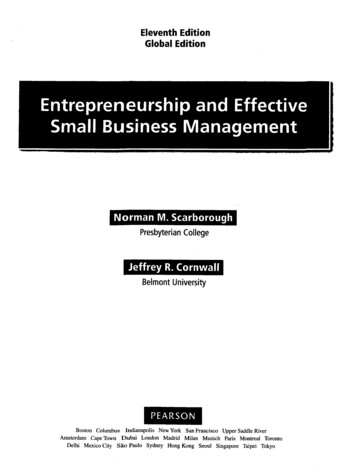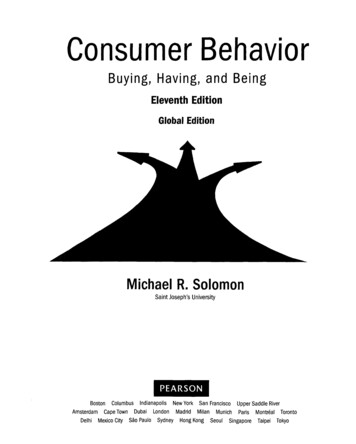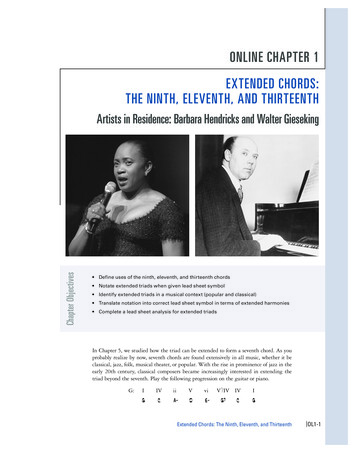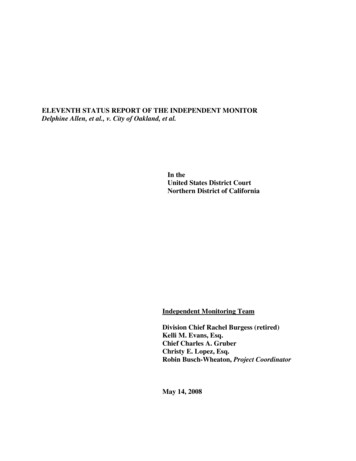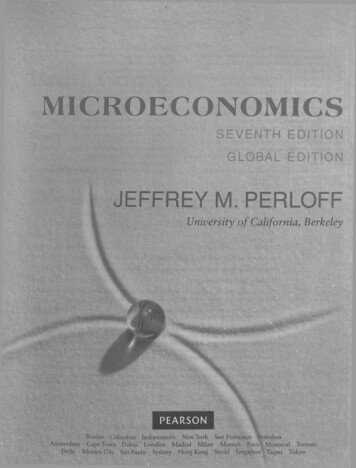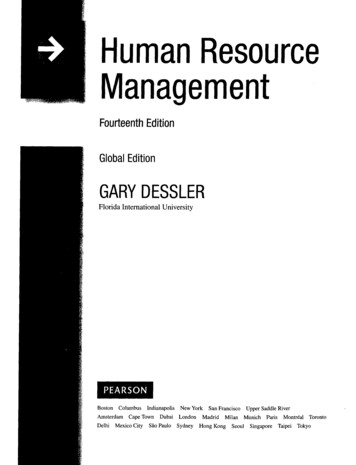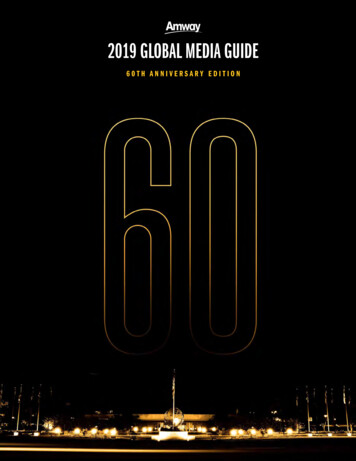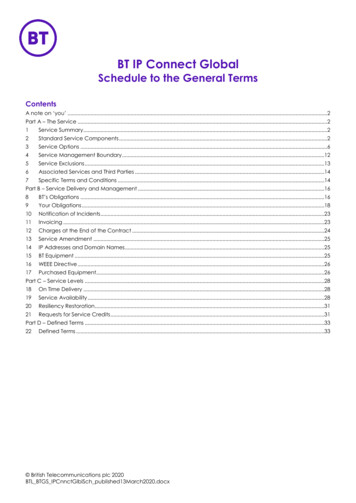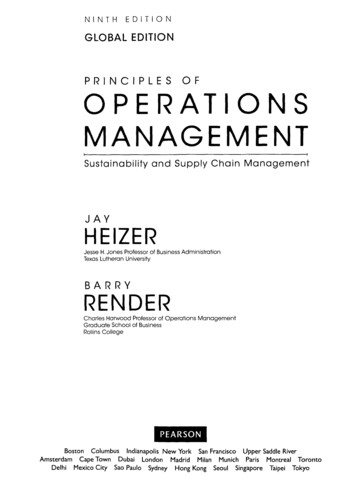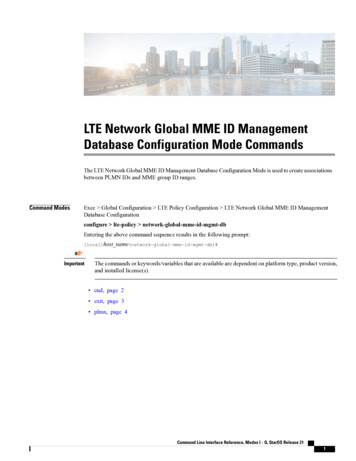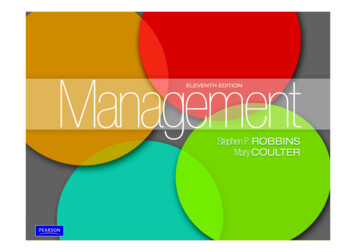
Transcription
Management, Eleventh Edition, Global Edition by Stephen P. Robbins & Mary Coulter 2012 Pearson Education1-1
Chapter 1: Foundations ofManagement and Organizations Explain why managers are important toorganizations Tell who managers are and where they work Describe the functions, roles, and skills ofmanagers Describe the factors that are reshaping andredefining the manager’s job Explain the value of studying managementManagement, Eleventh Edition, Global Edition by Stephen P. Robbins & Mary Coulter 2012 Pearson Education1-2
Why are Managers Important? Organizations need their managerial skills andabilities more than ever in these uncertain,complex, and chaotic times. Managerial skills and abilities are critical ingetting things done. The quality of the employee/supervisorrelationship is the most important variable inproductivity and loyalty.Management, Eleventh Edition, Global Edition by Stephen P. Robbins & Mary Coulter 2012 Pearson Education1-3
Who Are Managers? Manager– Someone whocoordinates andoversees the work ofother people so thatorganizational goals canbe accomplished.Management, Eleventh Edition, Global Edition by Stephen P. Robbins & Mary Coulter 2012 Pearson Education1-4
Classifying Managers First-line Managers - Individuals who managethe work of non-managerial employees. Middle Managers - Individuals who managethe work of first-line managers. Top Managers - Individuals who areresponsible for making organization-widedecisions and establishing plans and goals thataffect the entire organization.Management, Eleventh Edition, Global Edition by Stephen P. Robbins & Mary Coulter 2012 Pearson Education1-5
Exhibit 1-1: Levels of ManagementManagement, Eleventh Edition, Global Edition by Stephen P. Robbins & Mary Coulter 2012 Pearson Education1-6
Where Do Managers Work? Organization - A deliberate arrangement ofpeople assembled to accomplish some specificpurpose (that individuals independently couldnot accomplish alone). Common Characteristics of Organizations– Have a distinct purpose (goal)– Are composed of people– Have a deliberate structureManagement, Eleventh Edition, Global Edition by Stephen P. Robbins & Mary Coulter 2012 Pearson Education1-7
Exhibit 1-2: Characteristics ofOrganizationsManagement, Eleventh Edition, Global Edition by Stephen P. Robbins & Mary Coulter 2012 Pearson Education1-8
What Do Managers Do? Management involves coordinating andoverseeing the work activities of others sothat their activities are completed efficientlyand effectively.Management, Eleventh Edition, Global Edition by Stephen P. Robbins & Mary Coulter 2012 Pearson Education1-9
Effectiveness and Efficiency Efficiency– “Doing things right”– Getting the most outputfor the least inputsManagement, Eleventh Edition, Global Edition by Stephen P. Robbins & Mary Coulter Effectiveness– “Doing the right things”– Attaining organizationalgoals 2012 Pearson Education1-10
Exhibit 1-3: Efficiency and Effectivenessin ManagementManagement, Eleventh Edition, Global Edition by Stephen P. Robbins & Mary Coulter 2012 Pearson Education1-11
Management Functions Planning - Defining goals, establishing strategies toachieve goals, and developing plans to integrate andcoordinate activities. Organizing - Arranging and structuring work toaccomplish organizational goals. Leading - Working with and through people toaccomplish goals. Controlling - Monitoring, comparing, and correctingwork.Management, Eleventh Edition, Global Edition by Stephen P. Robbins & Mary Coulter 2012 Pearson Education1-12
Exhibit 1-4: Four Functions of ManagementManagement, Eleventh Edition, Global Edition by Stephen P. Robbins & Mary Coulter 2012 Pearson Education1-13
Management Roles Roles are specific actions or behaviorsexpected of a manager. Mintzberg identified 10 roles grouped aroundinterpersonal relationships, the transfer ofinformation, and decision making.Management, Eleventh Edition, Global Edition by Stephen P. Robbins & Mary Coulter 2012 Pearson Education1-14
Management Roles Interpersonal roles– Figurehead, leader, liaison Informational roles– Monitor, disseminator, spokesperson Decisional roles– Entrepreneur, disturbance handler, resourceallocator, negotiatorManagement, Eleventh Edition, Global Edition by Stephen P. Robbins & Mary Coulter 2012 Pearson Education1-15
Exhibit 1-5: Mintzberg’s Managerial RolesManagement, Eleventh Edition, Global Edition by Stephen P. Robbins & Mary Coulter 2012 Pearson Education1-16
Skills Managers Need Technical skills– Knowledge and proficiency in a specific field Human skills– The ability to work well with other people Conceptual skills– The ability to think and conceptualize aboutabstract and complex situations concerning theorganizationManagement, Eleventh Edition, Global Edition by Stephen P. Robbins & Mary Coulter 2012 Pearson Education1-17
Exhibit 1-6: Skills Needed at DifferentManagerial LevelsManagement, Eleventh Edition, Global Edition by Stephen P. Robbins & Mary Coulter 2012 Pearson Education1-18
Exhibit 1-7: Important Managerial SkillsManagement, Eleventh Edition, Global Edition by Stephen P. Robbins & Mary Coulter 2012 Pearson Education1-19
The Importance of Customers Customers: the reason that organizationsexist– Managing customer relationships is theresponsibility of all managers and employees.– Consistent high quality customer service isessential for survival.Management, Eleventh Edition, Global Edition by Stephen P. Robbins & Mary Coulter 2012 Pearson Education1-20
The Importance of Innovation Innovation– Doing things differently, exploring new territory,and taking risks.– Managers should encourage employees to beaware of and act on opportunities for innovation.Management, Eleventh Edition, Global Edition by Stephen P. Robbins & Mary Coulter 2012 Pearson Education1-21
The Importance of Sustainability Sustainability a company’s ability toachieve its businessgoals and increase longterm shareholder valueby integrating economic,environmental, andsocial opportunities intoits business strategies.Management, Eleventh Edition, Global Edition by Stephen P. Robbins & Mary Coulter 2012 Pearson Education1-22
Exhibit 1-8: Changes Facing ManagersManagement, Eleventh Edition, Global Edition by Stephen P. Robbins & Mary Coulter 2012 Pearson Education1-23
Why Study Management? Universality of Management– The reality that management is needed in all types and sizes of organizationsat all organizational levelsin all organizational areasin all organizations, regardless of locationManagement, Eleventh Edition, Global Edition by Stephen P. Robbins & Mary Coulter 2012 Pearson Education1-24
Exhibit 1-9: Universal Need forManagementManagement, Eleventh Edition, Global Edition by Stephen P. Robbins & Mary Coulter 2012 Pearson Education1-25
Exhibit 1-10: Rewards and Challenges ofBeing a ManagerManagement, Eleventh Edition, Global Edition by Stephen P. Robbins & Mary Coulter 2012 Pearson Education1-26
Terms to Know managerfirst-line managersmiddle managerstop rganizingleadingcontrollingManagement, Eleventh Edition, Global Edition by Stephen P. Robbins & Mary Coulter management rolesinterpersonal rolesinformational rolesdecisional rolestechnical skillshuman skillsconceptual skillsorganizationuniversality of management 2012 Pearson Education1-27
Management, Eleventh Edition, Global Edition by Stephen P. Robbins & Mary Coulter 2012 Pearson Education1-28
Management, Eleventh Edition, Global Edition by Stephen P. Robbins & Mary Coulter 2012 Pearson Education2-1
Chapter 2: Constraints andChallenges for the Global Manager Contrast the actions of managers according to theomnipotent and symbolic views Describe the constraints and challenges facing managers intoday’s external environment Discuss the characteristics and importance of organizationalculture Describe current issues in organizational cultureManagement, Eleventh Edition, Global Edition by Stephen P. Robbins & Mary Coulter 2012 Pearson Education2-2
The Manager:Omnipotent or Symbolic? Omnipotent View of Management - the viewthat managers are directly responsible for anorganization’s success or failure. Symbolic view of Management - the viewthat much of an organization’s success orfailure is due to external forces outsidemanagers’ control.Management, Eleventh Edition, Global Edition by Stephen P. Robbins & Mary Coulter 2012 Pearson Education2-3
Exhibit 2-1: Constraints on Managerial DiscretionManagement, Eleventh Edition, Global Edition by Stephen P. Robbins & Mary Coulter 2012 Pearson Education2-4
The External Environment:Constraints and Challenges External Environment - those factors and forcesoutside the organization that affect its performance. Components of the External Environment– Specific environment: External forces that have a directand immediate impact on the organization– General environment: Broad economic, socio-cultural,political/legal, demographic, technological, and globalconditions that may affect the organizationManagement, Eleventh Edition, Global Edition by Stephen P. Robbins & Mary Coulter 2012 Pearson Education2-5
Exhibit 2-2: Components of External EnvironmentManagement, Eleventh Edition, Global Edition by Stephen P. Robbins & Mary Coulter 2012 Pearson Education2-6
Environmental Uncertainty andComplexity Environmental Uncertainty - the degree ofchange and complexity in an organization’senvironment. Environmental Complexity - the number ofcomponents in an organization’s environmentand the extent of the organization’sknowledge about those components.Management, Eleventh Edition, Global Edition by Stephen P. Robbins & Mary Coulter 2012 Pearson Education2-7
Exhibit 2-3: Environmental Uncertainty MatrixManagement, Eleventh Edition, Global Edition by Stephen P. Robbins & Mary Coulter 2012 Pearson Education2-8
Who Are Stakeholders? Stakeholders - any constituencies in theorganization’s environment that are affectedby an organization’s decisions and actions.Management, Eleventh Edition, Global Edition by Stephen P. Robbins & Mary Coulter 2012 Pearson Education2-9
Exhibit 2-4: Organizational StakeholdersManagement, Eleventh Edition, Global Edition by Stephen P. Robbins & Mary Coulter 2012 Pearson Education2-10
Managing Stakeholder Relationships1. Identify the organization’s externalstakeholders.2. Determine the particular interests andconcerns of external stakeholders.3. Decide how critical each external stakeholderis to the organization.4. Determine how to manage each individualexternal stakeholder relationship.Management, Eleventh Edition, Global Edition by Stephen P. Robbins & Mary Coulter 2012 Pearson Education2-11
What Is Organizational Culture? Organizational Culture - The shared values,principles, traditions, and ways of doing thingsthat influence the way organizationalmembers act. Strong Cultures - Organizational cultures inwhich key values are intensely held andwidely shared.Management, Eleventh Edition, Global Edition by Stephen P. Robbins & Mary Coulter 2012 Pearson Education2-12
Exhibit 2-5: Dimensions of Organizational CultureManagement, Eleventh Edition, Global Edition by Stephen P. Robbins & Mary Coulter 2012 Pearson Education2-13
Where Does Culture Come From? Organization founder Vision and mission Past practices Top managementbehavior Socialization - Theprocess that helpsemployees adapt to theorganization’s culture.Management, Eleventh Edition, Global Edition by Stephen P. Robbins & Mary Coulter 2012 Pearson Education2-14
How Do Employees Learn Culture? Stories - Narratives of significant events orpeople, e.g. organization founders, rulebreaking, reaction to past mistakes etc. Rituals - Sequences of activities that expressand reinforce the important values and goalsof the organizationManagement, Eleventh Edition, Global Edition by Stephen P. Robbins & Mary Coulter 2012 Pearson Education2-15
How Employees Learn Culture (cont.) Material Artifacts and Symbols - Convey thekinds of behavior that are expected, e.g. risktaking, participation, authority, etc. Language - Acts as a common denominatorthat bonds membersManagement, Eleventh Edition, Global Edition by Stephen P. Robbins & Mary Coulter 2012 Pearson Education2-16
Exhibit 2-6: Contrasting Organizational CulturesManagement, Eleventh Edition, Global Edition by Stephen P. Robbins & Mary Coulter 2012 Pearson Education2-17
Exhibit 2-7: Strong vs. Weak CulturesManagement, Eleventh Edition, Global Edition by Stephen P. Robbins & Mary Coulter 2012 Pearson Education2-18
Benefits of a Strong Culture Creates a stronger employee commitment tothe organization Aids in the recruitment and socialization ofnew employees Fosters higher organizational performance byinstilling and promoting employee initiativeManagement, Eleventh Edition, Global Edition by Stephen P. Robbins & Mary Coulter 2012 Pearson Education2-19
Exhibit 2-8: Establishing and Maintaining CultureManagement, Eleventh Edition, Global Edition by Stephen P. Robbins & Mary Coulter 2012 Pearson Education2-20
How Does Culture Affect Managers? Cultural Constraints on Managers– Whatever managerial actions the organizationrecognizes as proper or improper on its behalf– Whatever organizational activities theorganization values and encourages– The overall strength or weakness of theorganizational cultureManagement, Eleventh Edition, Global Edition by Stephen P. Robbins & Mary Coulter 2012 Pearson Education2-21
Exhibit 2-9: Managerial DecisionsAffected by CultureManagement, Eleventh Edition, Global Edition by Stephen P. Robbins & Mary Coulter 2012 Pearson Education2-22
How Do You Create a CustomerResponsive Culture? Hire the right type of employees (those with astrong interest in serving customers) Have few rigid rules, procedu
Management, Eleventh Edition, Global Edition by Stephen P. Robbins & Mary Coulter 2012 Pearson Education 1-2 Explain whymanagers are important to organizations Tell who managers are and where they work De ribe thefunctions, roles, and skills of managers De ribe thefactors that are reshaping and redefining the manager’s job Explain thevalue of studying management
